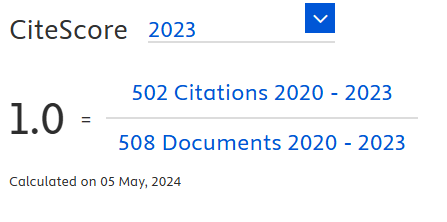Carbazole alkaloids Koenigicine, Koenigine, Mahanine and Mukonicineas Multi-Target Inhibitors in Triple-Negative Breast Cancer: Insights into MMP9, MMP13, EGFR, and NUDT5 Interactions through Molecular Docking
DOI:
https://doi.org/10.18006/2025.13(1).97.107Keywords:
Carbazolealkaloids, Triple-negative breast cancer (TNBC), Molecular docking, Multi-target inhibitors, MMP9, MMP13, EGFR, NUDT5Abstract
Plant-based natural products have been widely used for treating and preventing diseases due to their nutritional and pharmacological benefits, significantly improving the health and well-being of individuals. These medicinal plants are also easily accessible and offer a low-cost, less harmful source for developing new medications. Breast cancer is the second most common form of cancer reported in women worldwide. The treatment of triple-negative breast cancer (TNBC) remains challenging, as this subtype lacks targeted therapeutics. TNBC accounts for approximately 15-20% of newly diagnosed breast cancer cases. Because TNBC tumors do not express estrogen receptors (ER), progesterone receptors (PR), or human epidermal growth factor receptor 2 (HER2), patients with TNBC do not benefit significantly from treatments aimed at ER, PR and HER2-positive breast tumors. While TNBC initially responds well to chemotherapy, it often develops resistance over time, complicating disease management and presenting a significant clinical challenge. To address therapy resistance and improve patient outcomes, exploring new therapeutic options for TNBC is essential. This molecular docking study shows strong interactions between the carbazole alkaloids Koenigicine, Koenigine, Mahanine, and Mukonicine with key oncogenic protein targets such as MMP9, MMP13, NUDT5, and EGFR, which are associated with TNBC progression. The binding energy of these molecules ranges from -7.4 to -9.9 kcal/mol, indicating a very high potential for inhibition. Mahanine exhibits the highest binding affinity for all tested targets, demonstrating strong interactions with NUDT5 (-9.8 kcal/mol) and EGFR (-9.9 kcal/mol). This suggests its potential role as a multi-target inhibitor. The primary non-covalent interactions that contribute to the binding of carbazole alkaloids with target proteins include Van der Waals forces, hydrogen bonds, alkyl interactions, π-alkyl interactions, and π-π stacking. These interactions are crucial for stabilizing the ligand-protein complexes, enhancing binding affinity, and likely influencing the inhibitory effects of the compounds on TNBC-associated oncogenic proteins. The results of this study highlight the potential role of carbazole alkaloids in TNBC treatment, warranting further experimental validation.
References
Ajay, S., Rahul, S., Sumit, G., Paras, M., Mishra, A., & Gaurav, A. (2011). Comprehensive review: Murraya koenigii Linn. Asian Journal of Pharmacy and Life Science, 1(4), 417-425.
Almutairi, S., Kalloush, H. M., Manoon, N. A., & Bardaweel, S. K. (2023). Matrix Metalloproteinases Inhibitors in Cancer Treatment: An Updated Review (2013–2023). Molecules, 28(14), 5567. https://doi.org/10.3390/molecules28145567. DOI: https://doi.org/10.3390/molecules28145567
Arif, M. A. A., Warsito, S. H., Lamid, M., Lokapirnasari, W. P., Khairullah, A. R., et al. (2024). Phytochemical Analysis of Curry Leaf Extract (Murraya koenigii L.) as a Potential Animal Feed and Medicinal Ingredient. Pharmacognosy Journal, 16(2), 471–477. https://doi.org/10.5530/pj.2024.16.75 DOI: https://doi.org/10.5530/pj.2024.16.75
Atanasov, A. G., Waltenberger, B., Pferschy-Wenzig, E., Linder, T., Wawrosch, C., et al. (2015). Discovery and resupply of pharmacologically active plant-derived natural products: A review. Biotechnology Advances, 33(8), 1582–1614. https://doi.org/10.1016/j.biotechadv.2015.08.001 DOI: https://doi.org/10.1016/j.biotechadv.2015.08.001
Bai, X., Ni, J., Beretov, J., Graham, P., & Li, Y. (2021). Triple-negative breast cancer therapeutic resistance: Where is the Achilles' heel?. Cancer Letters, 497, 100–111. https://doi.org/10.1016/j.canlet.2020.10.016. DOI: https://doi.org/10.1016/j.canlet.2020.10.016
Balakrishnan, R., Vijayraja, D., Jo, S. H., Ganesan, P., Su-Kim, I., & Choi, D. K. (2020). Medicinal profile, phytochemistry, and pharmacological activities of Murraya koenigii and its primary bioactive compounds. Antioxidants, 9(2), 101. https://doi.org/10.3390/antiox9020568 DOI: https://doi.org/10.3390/antiox9020101
Beć, K., Grabska, J., & Huck, C. (2020). Biomolecular and bioanalytical applications of infrared spectroscopy - A review. Analytica Chimica Acta, 1133, 150–177. https://doi.org/10.1016/j.aca.2020.04.015. DOI: https://doi.org/10.1016/j.aca.2020.04.015
Cheang, M. C., Voduc, D., Bajdik, C., Leung, S., McKinney, S., Chia, S. K., Perou, C. M., & Nielsen, T. O. (2008). Basal-Like Breast Cancer Defined by Five Biomarkers Has Superior Prognostic Value than Triple-Negative Phenotype. Clinical Cancer Research, 14(5), 1368–1376. https://doi.org/10.1158/1078-0432.ccr-07-1658. DOI: https://doi.org/10.1158/1078-0432.CCR-07-1658
Dassault Systèmes BIOVIA (2016). Discovery Studio Modelling Environment, Release 2017; Dassault Systèmes: San Diego, CA, USA.
Dubey, A., Alanazi, A.M., Bhardwaj, R., & Ragusa, A. (2024). Identification of potential NUDT5 inhibitors from marine bacterial natural compounds via molecular dynamics and free energy landscape analysis. Molecular Diversity, 29 (1), 1-15, https://doi.org/10.1007/s11030-024-10950-5. DOI: https://doi.org/10.1007/s11030-024-10950-5
Endo, H., Owada, S., Inagaki, Y., Shida, Y., & Tatemichi, M. (2018). Glucose starvation induces LKB1-AMPK-mediated MMP-9 expression in cancer cells. Scientific Reports 8,10122. https://doi.org/10.1038/s41598-018-28074-w. DOI: https://doi.org/10.1038/s41598-018-28074-w
Gaikwad, S., Gawande, V., Mhaske, S., & Sharma, T. (2025). A review on the medicinal significance of Murraya koenigii. International Journal of Pharmaceutical Sciences, 3(1), 166–174. https://doi.org/10.5281/zenodo.14590932.
Gangawat, R., Parashar, R., & Yadav, R. K. (2024). Hepatoprotective Potential of Murraya koenigii (Curry Leaves) against Xenobiotics, Heavy Metals, and Hepatotoxic Agents: A Comprehensive Review. Current Drug Discovery Technologies, (in press). https://doi.org/10.2174/0115701638310869240628060001. DOI: https://doi.org/10.2174/0115701638310869240628060001
Ghosh, S., Ghosh, S., & Wategaonkar, S. (2020). C–H•••Y (Y=N, O, π) Hydrogen Bond: A Unique Unconventional Hydrogen Bond. Journal of the Indian Institute of Science, 100(1), 101–125. https://doi.org/10.1007/S41745-019-00145-5. DOI: https://doi.org/10.1007/s41745-019-00145-5
Gonzalez-Avila, G., Sommer, B., Mendoza-Posada, D. A., Ramos, C., Garcia-Hernandez, A. A., & Falfan-Valencia, R. (2019). Matrix metalloproteinases participation in the metastatic process and their diagnostic and therapeutic applications in cancer. Critical reviews in oncology/hematology, 137, 57-83. DOI: https://doi.org/10.1016/j.critrevonc.2019.02.010
Hansen, P.E., Vakili, M., Kamounah, F.S., & Spanget-Larsen, J. (2021). NH Stretching Frequencies of Intramolecularly Hydrogen-Bonded Systems: An Experimental and Theoretical Study. Molecules, 26(24), 7651. https://doi.org/10.3390/molecules26247651. DOI: https://doi.org/10.3390/molecules26247651
Kar, T., Dugam, P., Shivhare, S. C., Shetty, S. R., Choudhury, S., et al. (2024). Epidermal growth factor receptor inhibition potentiates chemotherapeutics‐mediated sensitization of metastatic breast cancer stem cells. Cancer Reports, 7. https://doi.org/10.1002/cnr2.2049. DOI: https://doi.org/10.1002/cnr2.2049
Leidy, J., Khan, A., & Kandil, D. (2014). Basal-Like Breast Cancer: Update on Clinicopathologic, Immunohistochemical, and Molecular Features. Archives of Pathology & Laboratory Medicine, 138(1), 37–43. https://doi.org/10.5858/arpa.2012-0439-ra. DOI: https://doi.org/10.5858/arpa.2012-0439-RA
Lejeune, M., Reverté, L., Gallardo, N., Sauras, E., Bosch, R., et al. (2023). Matrix Metalloproteinase-9 Expression is Associated with the Absence of Response to Neoadjuvant Chemotherapy in Triple-Negative Breast Cancer Patients. International Journal of Molecular Sciences, 24(14), 11297. https://doi.org/10.3390/ijms241411297 DOI: https://doi.org/10.3390/ijms241411297
Lorion, C., Bardin, V., Bonnet, S., Lopez‐Gaydon, A., Vogelgesang, B., & Bechetoille, N. (2023). Elastogenic potential and antisagging properties of a novel Murraya koenigii extract. Journal of Cosmetic Dermatology, 23(3), 1036–1044. https://doi.org/10.1111/jocd.16059. DOI: https://doi.org/10.1111/jocd.16059
Mandel, A., Larsson, P., Sarwar, M., Semenas, J., Khaja, A. S. S., & Persson, J. L. (2018). The interplay between AR, EGF receptor and MMP-9 signaling pathways in invasive prostate cancer. Molecular Medicine, 24(1) 34. https://doi.org/10.1186/s10020-018-0035-4. DOI: https://doi.org/10.1186/s10020-018-0035-4
Mcule (2024). Mcule: A Platform for Molecular Design and Drug Discovery. Available at mcule.com.
National Center for Biotechnology Information. (2024). Compound summary for CID -278055 (Koenigicine), 5318825 (Koenigine), 36689305 (Mahanine), 86242003 (Mukonicine). PubChem. Retrieved October 10, 2024, from https://pubchem.ncbi.nlm.nih.gov/compound/.
Nedeljković, M., & Damjanović, A. (2019). Mechanisms of Chemotherapy Resistance in Triple-Negative Breast Cancer-How We Can Rise to the Challenge. Cells, 8(9), 957. doi: 10.3390/cells8090957. DOI: https://doi.org/10.3390/cells8090957
Newman, D. J., & Cragg, G. M. (2020). Natural Products as Sources of New Drugs over the Nearly Four Decades from 01/1981 to 09/2019. Journal of Natural Products, 83(3), 770–803. https://doi.org/10.1021/acs.jnatprod.9b01285. DOI: https://doi.org/10.1021/acs.jnatprod.9b01285
Ozaki, Y. (2021). Infrared spectroscopy—Mid-infrared, near-infrared, and far-infrared/terahertz spectroscopy. Analytical Sciences, 37(9), 1193–1212. https://doi.org/10.2116/ANALSCI.20R008. DOI: https://doi.org/10.2116/analsci.20R008
Patil, R., Mandlik, S., & Mandlik, D. (2023). Murraya koenigii (Curry Tree): A review of its Phytochemistry, Ethnomedicinal uses, and Pharmacology with Respect to Molecular Mechanisms. Current Traditional Medicine, 10(5), 73-79. https://doi.org/10.2174/2215083810666230609163404. DOI: https://doi.org/10.2174/2215083810666230609163404
Pinto, P., & Cojandaraj, L. (2024). Protective Effects of Murraya koenigii: Focus on Antihyperlipidemic Property. Current Drug Therapy, 20(1), 24-32. https://doi.org/10.2174/ 0115748855278592240131105512. DOI: https://doi.org/10.2174/0115748855278592240131105512
Polik, W.F., & Schmidt, J.R. (2022). WebMO: Web-based computational chemistry calculations in education and research. WIREs Computational Molecular Science, 12, e1554. https://doi.org/10.1002/wcms.1554. DOI: https://doi.org/10.1002/wcms.1554
Pradhan, S. P., Subedi, I., Adhikari, K., Gc, A., Pradhan, S. P., Aryal, M. R., Ghimire, G. P., & Pandey, B. P. (2024). In vitro and in silico approach for the evaluation of enzyme inhibitory potential of Kadipatta (Murraya koenigii) collected from western Nepal. Deleted Journal, 5(3), 200161. https://doi.org/10.1016/j.ctmp.2024.200161. DOI: https://doi.org/10.1016/j.ctmp.2024.200161
Qian, J., Ma, Y., Tahaney, W. M., Moyer, C. L., Lanier, A., et al. (2024). The novel phosphatase NUDT5 is a critical regulator of triple-negative breast cancer growth. Breast Cancer Research : BCR, 26(1), 23. https://doi.org/10.1186/s13058-024-01778-w. DOI: https://doi.org/10.1186/s13058-024-01814-9
Sadwal, S., Bharati, S., Dar, Z. A., & Kaur, S. (2023). Chemopreventive potential of hydroethanolic Murraya koenigii leaves extract against DMBA induced breast carcinogenesis: In-silico and in-vivo study. Journal of Ethnopharmacology, 319, 117124. https://doi.org/10.1016/j.jep.2023.117124. DOI: https://doi.org/10.1016/j.jep.2023.117124
Samanta, S.K., Choudhury, P., Kandimalla, R., Aqil, F., Moholkar, D.N., et al. (2024). Mahanine mediated therapeutic inhibition of estrogen receptor-α and CDK4/6 expression, decipher the chemoprevention-signaling cascade in preclinical model of breast cancer. Journal of Ethnopharmacology, 319 (2), 117235. https://doi.org/10.1016/j.jep.2023.117235. DOI: https://doi.org/10.1016/j.jep.2023.117235
Suvarna, E., Setlur, A. S., Chandrashekar, S., & Niranjan, V. (2024). Computational molecular perspectives on novel carbazole derivative as an anticancer molecule against CDK1 of breast and colorectal cancers via gene expression studies, novel two-way docking strategies, molecular mechanics and dynamics. Computational Biology and Chemistry, 108, 107979. https://doi.org/10.1016/j.compbiolchem.2023.107979. DOI: https://doi.org/10.1016/j.compbiolchem.2023.107979
Szczygielski, O., Dąbrowska, E., Niemyjska, S., Przylipiak, A., & Zajkowska, M. (2024). Targeting Matrix Metalloproteinases and Their Inhibitors in Melanoma. International Journal of Molecular Sciences, 25(24), 13558. https://doi.org/10.3390/ijms252413558. DOI: https://doi.org/10.3390/ijms252413558
Thomford, N. E., Senthebane, D. A., Rowe, A., Munro, D., Seele, P., Maroyi, A., & Dzobo, K. (2018). Natural Products for Drug Discovery in the 21st Century: Innovations for Novel Drug Discovery. International Journal of Molecular Sciences, 19(6), 1578. https://doi.org/10.3390/ijms19061578. DOI: https://doi.org/10.3390/ijms19061578
Wang, T., Tan, Y., Chen, Y., & Tan, C. (2023). Infrared spectral analysis for prediction of functional groups based on feature-aggregated deep learning. Journal of Chemical Information and Modeling, 63(15): 4615-4622. https://doi.org/10.1021/acs.jcim.3c00749. DOI: https://doi.org/10.1021/acs.jcim.3c00749
Yuan, H., Ma, Q., Ye, L., & Piao, G. (2016). The Traditional Medicine and Modern Medicine from Natural Products. Molecules, 21(5), 559. https://doi.org/10.3390/molecules21050559. DOI: https://doi.org/10.3390/molecules21050559
Zagami, P., & Carey, L.A. (2022). Triple negative breast cancer: Pitfalls and progress. NPJ Breast Cancer, 8(1), 95. https://doi.org/10.1038/s41523-022-00468-0. DOI: https://doi.org/10.1038/s41523-022-00468-0
Zhang, H., Qi, Y., Mao, Y., & Zheng, J. (2024). PDZK1 suppresses TNBC development and sensitizes TNBC cells to erlotinib via the EGFR pathway. Cell Death and Disease, 15(3), 199. https://doi.org/10.1038/s41419-024-06502-w. DOI: https://doi.org/10.1038/s41419-024-06502-2
Downloads
Published
How to Cite
License
Copyright (c) 2025 Journal of Experimental Biology and Agricultural Sciences

This work is licensed under a Creative Commons Attribution-NonCommercial 4.0 International License.












